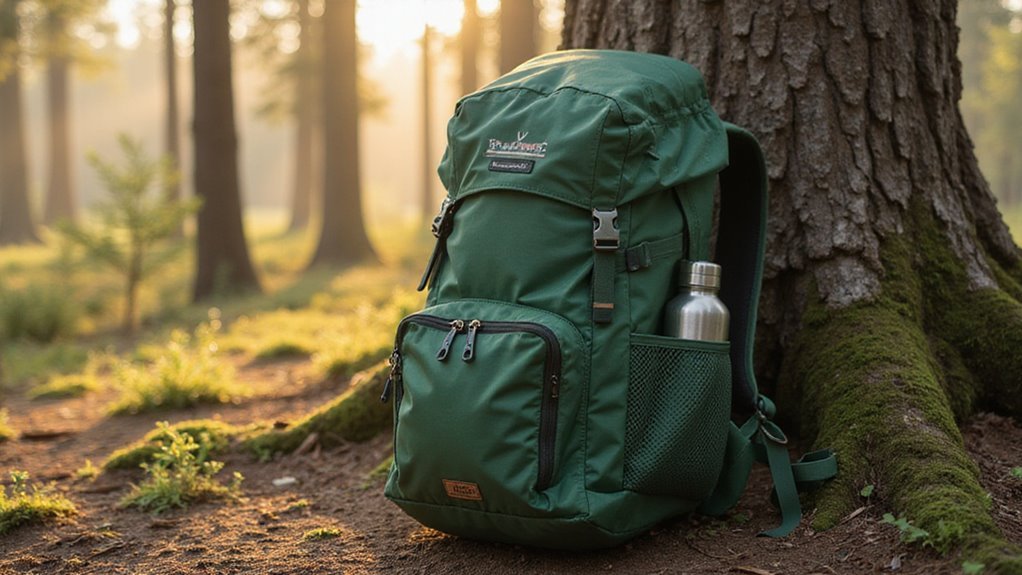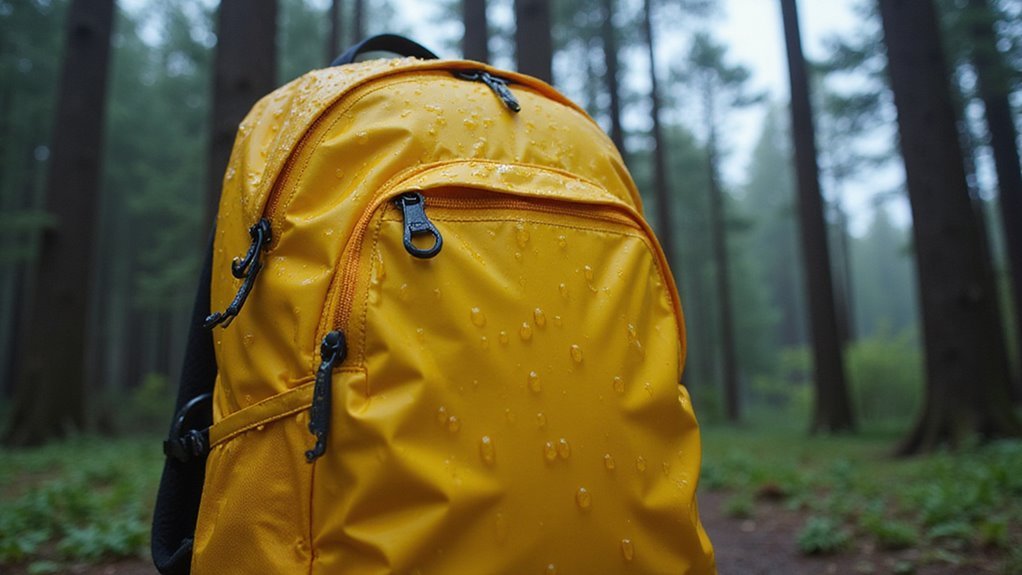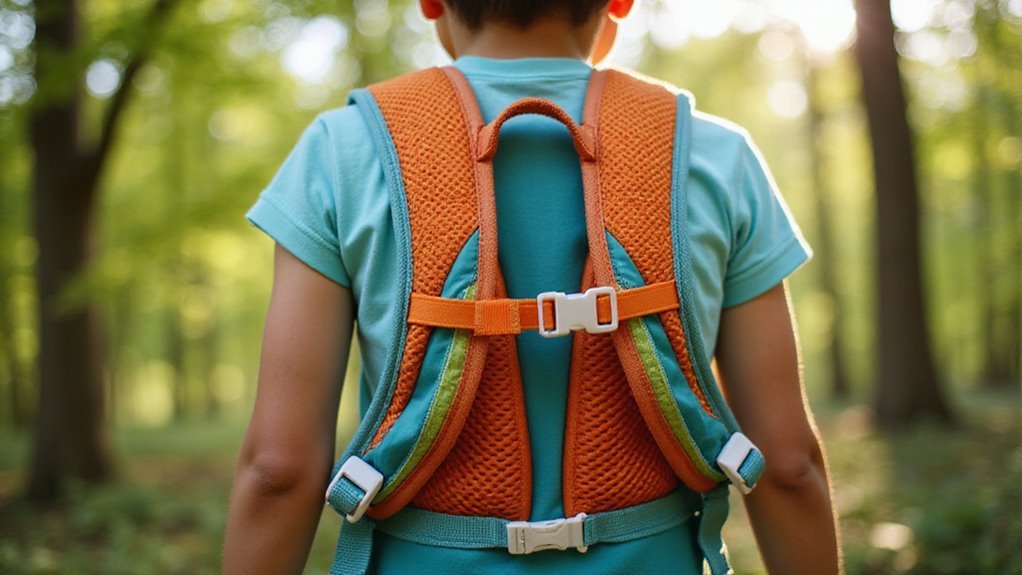Over 85% of traditional camping packs end up in landfills within five years of purchase. We’re not about to let that happen with our gear. Let’s explore how sustainable water-resistant packs are revolutionizing outdoor adventures through eco-friendly materials and innovative design. From recycled polyester shells to non-toxic waterproofing, these packs aren’t just protecting our gear – they’re protecting our planet. The future of outdoor equipment has arrived, and it’s greener than you’d expect.
Understanding Water-Resistant Pack Technology

While many campers assume their packs are fully waterproof, we’re here to set the record straight on water-resistant technology.
Water-resistant backpacks use specialized DWR coatings and treated materials to combat moisture seeping through during light rain. Don’t confuse this with bombproof protection – these packs handle splashes but won’t survive a dunking.
- Original & User-friendly Slim Laptop Backpack– This professional backpack men is a new and original design by the brand…
- Lightweight Large Capacity Backpack– Dimensions of laptop backpack men: 16.9″x11.8″x5.9″ inch, Lightweight Only: 2 LBS….
- Anti-Theft Backpack with USB Charging Port– The mens work backpack has a hidden pocket with a zipper in the back to hol…

Pack technology has evolved to include taped seams that prevent water ingress, but water exposure remains the enemy.
We’ll help you decode those cryptic IPX ratings and match the right level of protection to your camping needs. No more soggy surprises in your gear. Additionally, understanding waterproof rating systems is crucial for making informed choices about your gear’s performance in wet conditions.
Sustainable Materials in Modern Camping Packs
Modern camping packs aren’t just about keeping gear dry – they’re about keeping our planet healthy too.
We’re seeing recycled polyester and biodegradable fabrics like hemp leading the charge in sustainable materials. Non-toxic waterproof coatings have replaced harmful PFCs, while durable materials like TPU lamination extend pack lifespans.
Smart manufacturers are embracing Fair Trade Certified practices, creating gear that eco-conscious consumers can trust.
The sustainable lifecycle of today’s packs matters – from production to disposal. When we invest in these materials, we’re not just buying a pack; we’re investing in Earth’s future.
Essential Features of Eco-Conscious Adventurers

Because today’s eco-conscious adventurers demand more than just waterproofing, we’ve got to scrutinize every feature through a sustainability lens.
- VAULT CLASSIC. The much-loved Vault day pack has a sleek, modern aesthetic, a water-repellent finish and the ability to …
- FLEX VENT TECHNOLOGY. The FlexVent suspension system features a flexible yoke built from custom injection-molded and fle…
- TOTAL ORGANIZATION. A front compartment simplifies organization while maintaining essential features for storage with zi…

Let’s focus on what matters: water-resistant packs with PFC-free, eco-friendly coatings that actually protect aquatic ecosystems. We’re talking durable construction that’s built to last and easy to repair.
Look for modular features that adapt to different adventures – it’s smarter than buying multiple bags.
And don’t overlook recycled materials like repurposed nylon and polyester. When choosing waterproof backpacks, check the brand’s sustainable practices, such as their commitment to recycled materials to reduce plastic waste.
Your environmental impact matters, and every feature should reflect that commitment.
Comparing Pack Sizes and Weight Distribution
We’re looking at pack sizes ranging from ultralight 15L daypacks to robust 45L haulers for extended camping trips. Here’s the deal: weight distribution is everything.
Let’s nail the basics: adjustable straps and padded hip belts are non-negotiable for balanced load carrying. Lightweight materials keep your base weight down – we’re talking 1 pound for 15L to 3 pounds for 35L packs. Additionally, optimal weight distribution ensures that 80% of the load is carried on the hips and 20% on the shoulders for comfort. Position heavy gear close to your back and lighter items up top for maximum stability. Your perfect capacity? For weekend warriors, 28L hits the sweet spot.
Weather Protection and Durability Standards

When it comes to outdoor gear, weather protection isn’t just a feature – it’s survival.
We’ve found the best waterproof backpacks combine high-quality stitching and seam sealing to create an impenetrable barrier against rain and splashes. Look for packs with IPX4 ratings or higher.
Today’s durable water-resistant options feature abrasion-resistant fabrics made from recycled materials – proving sustainability doesn’t compromise performance. Proper fit is essential to ensure maximum effectiveness of your pack against the elements.
We recommend regular maintenance with waterproofing sprays to maintain weather protection standards.
Don’t forget to check seams and zippers periodically. Your pack’s durability depends on it.
Storage Solutions and Organization Systems
While traditional backpacks throw everything into one jumbled mess, today’s sustainable packs offer sophisticated organization that’ll transform how you camp.
We’re talking multiple organizational pockets crafted from eco-friendly materials, dedicated hydration bladder sleeves, and external water bottle storage – because fumbling for your drink is so last century.
Roll-top closures don’t just keep water out; they’re your ticket to adjustable storage solutions.
Add in modular systems with attachment points for waterproof bags and external storage solutions, and you’ve got a pack that adapts to your needs.
It’s like having a mobile gear closet, perfectly organized and ready for anything. Moreover, materials like Dyneema Composite Fabric enhance durability while keeping the pack lightweight.
Comfort and Ergonomic Design Elements

Because comfort makes or breaks any camping experience, sustainable pack designers obsess over ergonomic details that’ll keep you hiking happy.
We’ve seen smart innovations in padded shoulder straps curved to match body contours, while adjustable sternum straps and hip belts distribute weight evenly across your frame.
You’ll love how breathable back panels prevent that dreaded sweaty-back syndrome.
We’re talking lightweight materials that won’t weigh you down, plus modular designs for ultimate customization.
Trust us – these packs aren’t just environmentally conscious, they’re body-conscious too.
The customizable fit guarantees you’ll barely notice you’re carrying gear at all, as proper weight distribution ensures a balanced load that minimizes strain on your back and enhances comfort during long hikes.
Maintaining Your Sustainable Pack’s Performance
Your sustainable pack’s stellar ergonomics won’t mean much if you don’t maintain its performance.
Let’s keep your gear dry and functional with proper care. Regular cleaning with mild soap preserves water resistance, while inspecting zippers guarantees they’ll keep functioning as your first line of waterproof defense. Ensure your pack’s waterproofing treatments are reapplied every 6-10 months to maintain effectiveness. Store your pack in a cool, dry space between adventures – mold’s not invited to this party.
When water resistance starts to fade, reach for eco-friendly waterproofing sprays compatible with your dry bags.
And always (yes, always) follow manufacturer care instructions. They wrote them for a reason.
Frequently Asked Questions
What Is the Best Material for a Water-Resistant Backpack?
We’ve found treated nylon and polyester are best for water-resistant backpacks, offering durability and lightweight performance. They’re environmentally friendly when recycled, maintain effectiveness with proper care, and won’t break your budget.
What Is the Difference Between a Waterproof Backpack and a Water-Resistant Backpack?
We’ll find waterproof backpacks offer complete water protection with sealed seams and roll-top closures, while water-resistant ones provide basic protection against light moisture but won’t withstand heavy rain or submersion.
How Do You Make a Water-Resistant Bag?
We’ll stitch durable fabrics, apply waterproof coatings, and seal seams during bag construction. Once assembled, we test water resistance and maintain protection through regular drying and reapplication of water-repellent treatments.
Are Waterproof Bags Worth It?
We’d say waterproof bags are worth it for their benefits of protecting gear during outdoor activities. While prices vary, their durability and reliable performance make them a smart investment for adventurers.

